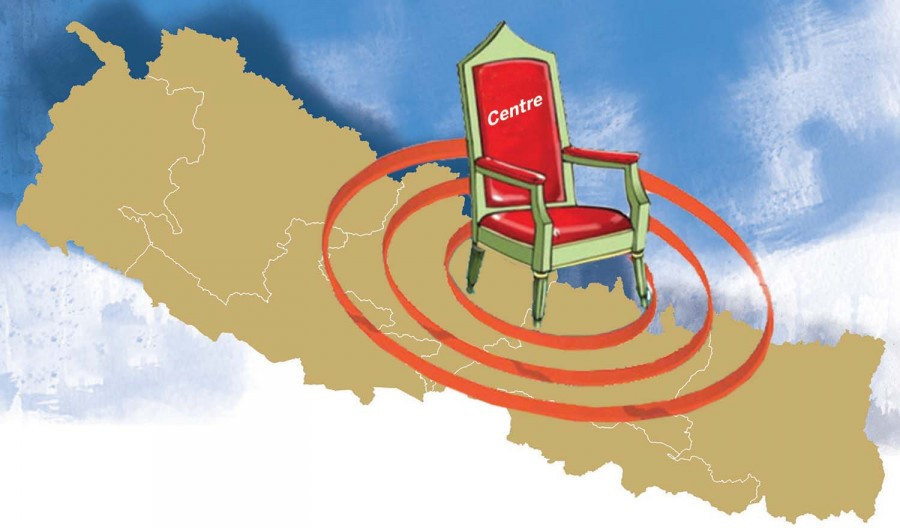Columns
Federalism vs centralised planning
Nepal's precarious socio-economic standing is the result of a highly centralised planning process.
Achyut Wagle
The National Planning Commission is currently working on the 16th periodic plan which will last for five years beginning July 2024. Since planned development began nearly seven decades ago, Nepal has gone through 10 five-year plans and five three-year plans. Despite all these plans, the country continues to languish among the very few impoverished nations on earth. The main reason behind Nepal's precarious socio-economic standing is this highly centralised planning process which has been a spectacular failure. One seeming progress is that Nepal's status as a least developed country may be upgraded to a middle-income country by 2026. But one question arises: How can that be called upgradation if Nepal remains among the bottom 10 or 20 countries as per its socio-economic indicators?
Despite several phenomenal changes in the country's political systems since the introduction of the first periodic plan in 1956—from democracy to Panchayat dictatorship in 1960, Panchayat to parliamentary democracy in 1990, republicanism in 2008 and federalism in 2015—Nepal could not rid itself of its fatal attraction for centralised planning. Even today, the ruling elite and political organisations do not see that centralised planning is antithetic to the federal polity the country has adopted.
Archaic model
The formulation of five-year plans by a central government agency like the National Planning Commission is perhaps among the last relics of Soviet-era centralised planning. The then Soviet leader Joseph Stalin had introduced centralised planning in 1929 with the goal of achieving rapid industrialisation by employing the harshest means to exploit labour. The phenomenon became a permanent economic feature of not only the Soviet Union until it dissolved in 1989 and other communist countries, but also many self-declared socialism-oriented countries like post-colonial India.
There is an abundance of post-Soviet era economic literature to suggest that the central planning or command economic model was an unequivocal failure. For example, India stagnated for four and a half decades since 1947 at what is infamously known as the Hindu rate of growth. Even China's staggering rate of economic growth during the last two decades, in particular, is attributed to its ability to shed the obsession with centralisation and move to market socialism and economic openness despite its essentially single-party authoritarian dispensation.
Centralised planning may be justified in an authoritarian regime where the will of the sole ruler is reflected in the planning, and the implementation mechanism also functions as per the ruler's wishes.
But in an open democracy where Parliament is at the helm of policymaking, and in a federal democracy where matching the developmental needs of the electorate with the elected executives is the basis of planning, centralised planning does not and should not have a role. Therefore, in a democracy, periodic plans are never a mandatory legal document. In every sense, the political leadership does not take ownership of the plans and the responsibility to implement them.
The formulation of periodic plans becomes more an exercise in essay writing than an exercise in planning. Overambitious propositions and projections are inserted without proper evidence from the demand side and without assurance of resources on the supply side. In other words, resource mobilisation is invariably expected to be incremental while output projections are exponential, primarily for cheap populism in the political interest of the incumbent party.
The necessity of a proper review of even the immediate past plan is barely realised. The concept note of the proposed 16th plan which was circulated for discussion, for example, has failed to undertake a comprehensive review of the 15th five-year plan and pinpoint the reasons for its failure to deliver.
The 15th plan had projected an installed hydropower capacity of 5,000 megawatts by the end of the plan period, generation of 500,000 jobs each year, an average economic growth rate of 9-10 percent and a per capita income of over $1,400. Except closing the gap in per capita income, hundreds of other indicators are way short of even the halfway mark. What are the reasons for such a massive failure of the plan? Should anybody be held responsible for it? There is no agency to answer these critical questions.
Why this should stop
Office-bearers of the National Planning Commission are already on the defensive when confronted with the question whether they can convince the government to implement the 16th plan they are now formulating. Besides, their way of gathering information about the developmental needs through focal group discussions can hardly replace the evidence substantiated through non-probabilistic primary data. On top of that, they have a political obligation to incorporate the most implausible plans dictated by their political masters.
The drama of formulating a long-term developmental and economic plan by the central government agency as if it understands the needs of the people all over the country must stop right away. This exercise is a clear duplication of what the national budget should envision and implement. This is also an infringement on the authority of the subnational units created to exercise fiscal autonomy in the true spirit of federalism. The political leadership must resist the temptation to appoint their cadres to the lucrative positions of vice-chair and members of a redundant entity, the National Planning Commission. From every angle, anything in the new 16th plan will have no relevance or rationale.




 6.73°C Kathmandu
6.73°C Kathmandu















